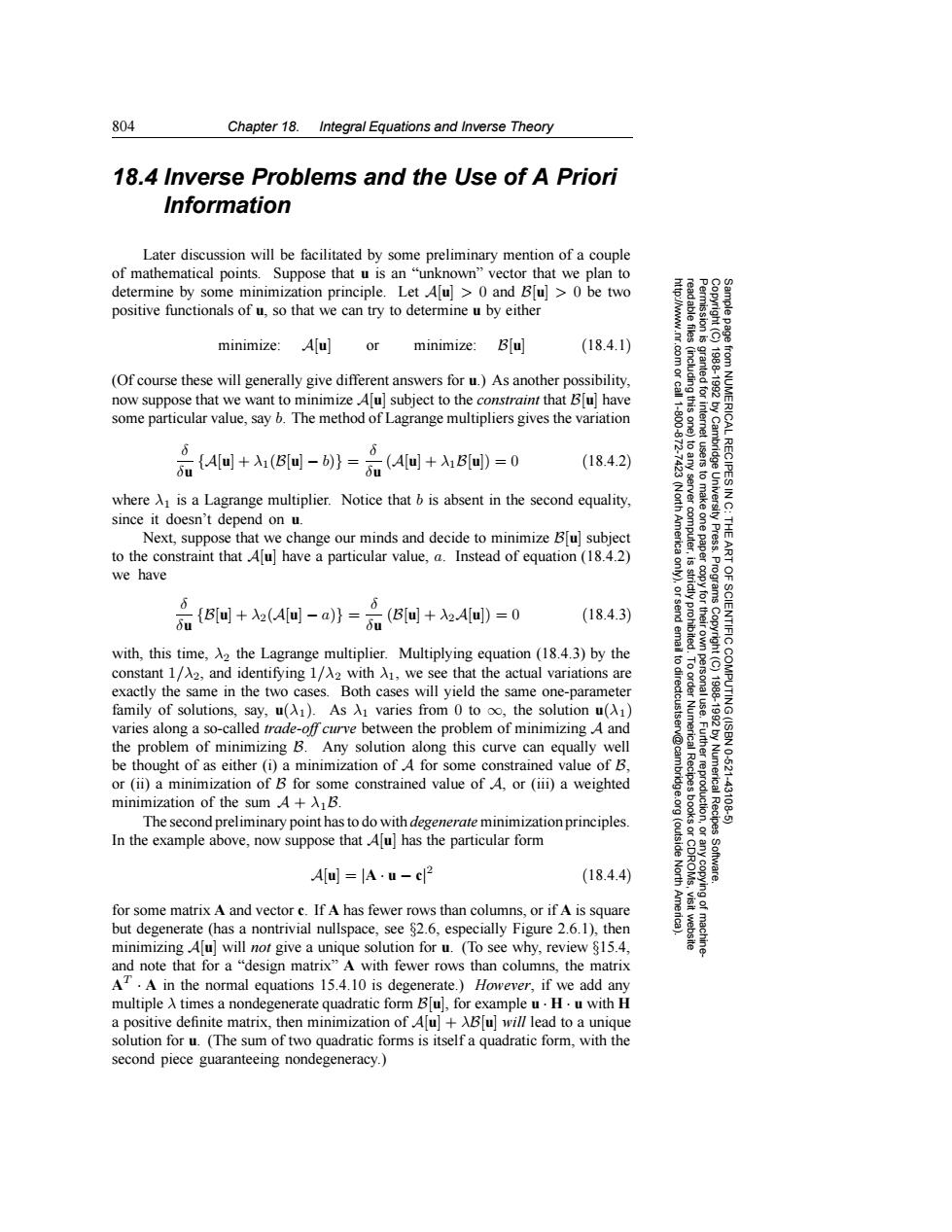正在加载图片...

804 Chapter 18.Integral Equations and Inverse Theory 18.4 Inverse Problems and the Use of A Priori Information Later discussion will be facilitated by some preliminary mention of a couple of mathematical points.Suppose that u is an "unknown"vector that we plan to determine by some minimization principle.Let A[u]>0 and Blu]>0 be two positive functionals of u,so that we can try to determine u by either minimize:Au or minimize:B[u] (18.4.1) 8 (Of course these will generally give different answers for u.)As another possibility, now suppose that we want to minimize Au]subject to the constraint that Bu]have some particular value,say b.The method of Lagrange multipliers gives the variation 0 {4[u+X1(Bu-b)}=。(4[u+1B[▣)=0 (18.4.2) RECIPES where A is a Lagrange multiplier.Notice that b is absent in the second equality, 9 since it doesn't depend on u. Next,suppose that we change our minds and decide to minimize B[u]subject to the constraint that Alu]have a particular value,a.Instead of equation(18.4.2) we have 、豆之w 9 9 6 0 {B网+(A回-a}=a(B[回+4)=0 (18.4.3) with,this time,A2 the Lagrange multiplier.Multiplying equation(18.4.3)by the 61 constant 1/A2,and identifying 1/A2 with A1,we see that the actual variations are exactly the same in the two cases.Both cases will yield the same one-parameter family of solutions,say,u(1).As A1 varies from 0 to oo,the solution u(1) varies along a so-called trade-off curve between the problem of minimizing A and the problem of minimizing B.Any solution along this curve can equally well be thought of as either (i)a minimization ofA for some constrained value of B, or(ii)a minimization of B for some constrained value ofA,or(iii)a weighted Numerica 10621 minimization of the sum A+AB. 43106 The second preliminary point has to do with degenerate minimization principles. In the example above,now suppose that Au]has the particular form A[回=A·u-c2 (18.4.4) for some matrix A and vector c.If A has fewer rows than columns,or if A is square but degenerate (has a nontrivial nullspace,see $2.6,especially Figure 2.6.1),then minimizing A[u]will not give a unique solution for u.(To see why,review 815.4, and note that for a"design matrix"A with fewer rows than columns,the matrix A.A in the normal equations 15.4.10 is degenerate.)However,if we add any multiple A times a nondegenerate quadratic form B[u],for example u.H.u with H a positive definite matrix,then minimization of Au+ABu]will lead to a unique solution for u.(The sum of two quadratic forms is itself a quadratic form,with the second piece guaranteeing nondegeneracy.)804 Chapter 18. Integral Equations and Inverse Theory Permission is granted for internet users to make one paper copy for their own personal use. Further reproduction, or any copyin Copyright (C) 1988-1992 by Cambridge University Press. Programs Copyright (C) 1988-1992 by Numerical Recipes Software. Sample page from NUMERICAL RECIPES IN C: THE ART OF SCIENTIFIC COMPUTING (ISBN 0-521-43108-5) g of machinereadable files (including this one) to any server computer, is strictly prohibited. To order Numerical Recipes books or CDROMs, visit website http://www.nr.com or call 1-800-872-7423 (North America only), or send email to directcustserv@cambridge.org (outside North America). 18.4 Inverse Problems and the Use of A Priori Information Later discussion will be facilitated by some preliminary mention of a couple of mathematical points. Suppose that u is an “unknown” vector that we plan to determine by some minimization principle. Let A[u] > 0 and B[u] > 0 be two positive functionals of u, so that we can try to determine u by either minimize: A[u] or minimize: B[u] (18.4.1) (Of course these will generally give different answers for u.) As another possibility, now suppose that we want to minimize A[u] subject to the constraint that B[u] have some particular value, say b. The method of Lagrange multipliers gives the variation δ δu {A[u] + λ1(B[u] − b)} = δ δu (A[u] + λ1B[u]) = 0 (18.4.2) where λ1 is a Lagrange multiplier. Notice that b is absent in the second equality, since it doesn’t depend on u. Next, suppose that we change our minds and decide to minimize B[u] subject to the constraint that A[u] have a particular value, a. Instead of equation (18.4.2) we have δ δu {B[u] + λ2(A[u] − a)} = δ δu (B[u] + λ2A[u]) = 0 (18.4.3) with, this time, λ2 the Lagrange multiplier. Multiplying equation (18.4.3) by the constant 1/λ2, and identifying 1/λ2 with λ1, we see that the actual variations are exactly the same in the two cases. Both cases will yield the same one-parameter family of solutions, say, u(λ1). As λ1 varies from 0 to ∞, the solution u(λ1) varies along a so-called trade-off curve between the problem of minimizing A and the problem of minimizing B. Any solution along this curve can equally well be thought of as either (i) a minimization of A for some constrained value of B, or (ii) a minimization of B for some constrained value of A, or (iii) a weighted minimization of the sum A + λ1B. The second preliminary point has to do with degenerateminimization principles. In the example above, now suppose that A[u] has the particular form A[u] = |A · u − c| 2 (18.4.4) for some matrix A and vector c. If A has fewer rows than columns, or if A is square but degenerate (has a nontrivial nullspace, see §2.6, especially Figure 2.6.1), then minimizing A[u] will not give a unique solution for u. (To see why, review §15.4, and note that for a “design matrix” A with fewer rows than columns, the matrix AT · A in the normal equations 15.4.10 is degenerate.) However, if we add any multiple λ times a nondegenerate quadratic form B[u], for example u · H · u with H a positive definite matrix, then minimization of A[u] + λB[u] will lead to a unique solution for u. (The sum of two quadratic forms is itself a quadratic form, with the second piece guaranteeing nondegeneracy.)